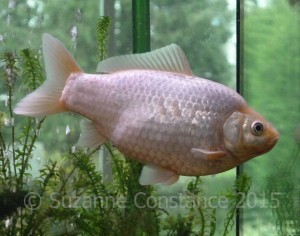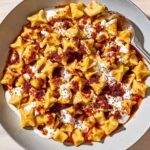Feeding your goldfish correctly is paramount to their health and longevity. As an aquarist with over two decades of experience keeping various goldfish breeds, I’ve learned that diet is often misunderstood. The common advice to “not overfeed” can be misleading, frequently resulting in underfed fish due to fear of overfeeding. While overfeeding is indeed detrimental, underfeeding is equally harmful.
The adage “do not overfeed” often stems from attempts to manage poor water quality in undersized tanks. Goldfish housed in appropriately sized tanks with proper maintenance, including regular water changes, can and should receive ample food. For a deeper understanding of tank size and its relation to feeding, refer to our comprehensive article on Do fish grow to the size of their tank?.
Understanding Goldfish Eating Habits and Nutritional Needs
Goldfish are omnivorous creatures with a broad appetite – they’ll try to eat almost anything. However, this doesn’t mean they should be fed just any food. Providing a balanced and appropriate diet is essential for their well-being.
Unlike humans, goldfish lack a stomach in the traditional sense. Digestion occurs as food moves through their intestines, where nutrients are extracted.
Instead of teeth in their mouths, goldfish possess pharyngeal teeth – hard plates located in their throat. These plates grind food before it’s swallowed. Goldfish are also adept “sifters.” They can take mouthfuls of substrate, plants, and food, expertly separating edibles from debris before expelling unwanted materials. You’ll often observe them sifting through gravel, ingesting and then spitting out substrate while retaining food particles.
Alt text: Singletail goldfish actively searching for food particles in the aquarium substrate.
Goldfish also graze around their environment, seeking out trapped food particles in plants or decorations, small invertebrates, and soft plant matter. They may also be seen at the water surface, investigating for food, which is normal behavior as they look for leftover food.
Dietary Differences: Singletail vs. Fancy Goldfish
Generally, singletail goldfish (like Commons and Comets) possess more robust digestive systems compared to fancy goldfish varieties (such as Ranchus, Orandas, and Ryukins). Singletails typically have a more streamlined, torpedo-shaped body, less affected by selective breeding. This natural body shape usually means their internal organs are well-positioned and properly developed. Consequently, they can generally handle a wider variety of foods, including both floating and sinking options. They usually don’t have issues with flake food, although larger singletails often prefer pellets for easier consumption of larger portions.
Fancy goldfish, with their selectively bred, compact body shapes, can sometimes experience digestive challenges. Their internal organs are often compressed, misshapen, or underdeveloped due to limited space within their bodies. The swim bladder, crucial for buoyancy, is also more susceptible to compression by the intestines. Food-related blockages can therefore significantly impact a fancy goldfish’s ability to swim properly. While not all fancy goldfish encounter these problems, caution is advised.
Alt text: Close-up of a black ranchu goldfish highlighting its characteristically compact and rounded body shape.
Optimal Food Choices for Goldfish Health
Variety is key to a healthy goldfish diet. While singletail goldfish can tolerate a broader range of foods, the following recommendations are particularly tailored for fancy goldfish, but are also suitable for singletails (who can additionally enjoy high-quality floating pellets and flakes).
Best Food Types for Fancy Goldfish
- Sinking Pellets: Sinking pellets are generally preferred over flake food for fancy goldfish. They minimize surface feeding, reducing the risk of air ingestion while eating. Look for high-quality brands specifically formulated for goldfish.
- Soaked Dry Food: Always soak dry foods like pellets for a short period (one to two minutes) in aquarium water before feeding. This pre-soaking prevents the food from expanding in the fish’s digestive tract, which can lead to indigestion and buoyancy issues. However, avoid over-soaking, as this can leach out essential nutrients.
- Frozen Foods (Defrosted): Offer defrosted frozen foods like bloodworms, brine shrimp, and daphnia. These provide essential protein and are highly palatable. Defrost a portion in a cup of water and rinse using a fine-mesh net or tea strainer before feeding to remove excess water and potential contaminants.
- Blanched Vegetables: Incorporate green vegetables into their diet. Blanched broccoli florets, spinach (microwave briefly until wilted), zucchini, and shelled, defrosted frozen peas are excellent choices. Spinach can be clipped to the tank glass using a vegetable clip. Broccoli and zucchini can be weighed down with a plant weight. Peas, once chopped, will sink naturally.
- Algae Wafers (Soaked): Soaked algae wafers can be offered as an occasional alternative to pellets, providing plant-based nutrition. Break them into smaller pieces and ensure they are well-soaked before feeding.
- Gel Food: Gel foods are a nutritious option. You can find recipes online to make your own, or purchase pre-made powders like Repashy Soilent Green, which you mix with hot water to create a gel. These are often packed with nutrients and fiber.
- Live Plants: Live plants like Elodea (Anacharis) are beneficial. They are inexpensive, grow quickly, and serve as a constant source of supplemental fiber and grazing opportunities for your goldfish.
Alt text: A well-fed fancy goldfish displaying a healthy, rounded body shape, indicative of proper nutrition.
Exploring Tropical Fish Food Options
While goldfish-specific food should be the staple, exploring high-quality tropical fish foods can add variety. Compare the protein and nutrient content of Goldfish Foods with tropical food formulations. Some tropical foods can be a suitable supplement. My goldfish, for example, enjoy bottom-feeder foods like earthworm pellets as occasional treats and even sterlet and sturgeon food designed for different species!
Feeding Frequency and Portion Sizes for Goldfish
Goldfish require relatively frequent feeding due to their metabolism and continuous grazing habits. It’s better to feed them smaller portions twice daily (morning and evening) rather than one large meal. I typically offer dry food in the morning and vegetables or frozen food in the evening. Spreading food around the tank encourages natural foraging behavior and prevents them from gulping down too much food at once. Younger, growing goldfish benefit from more frequent, smaller feedings, while adult goldfish thrive on twice-daily feedings. Maintaining live plants in the aquarium also ensures they have access to food between meals.
Determining the correct amount of food is a balancing act. Underfeeding is as problematic as overfeeding. The often-cited advice to feed “an amount equal to the size of the goldfish’s eye” is inadequate and inaccurate. Goldfish need significantly more food than that. A more practical guideline is to feed “as much as they can eat in a couple of minutes.” However, be mindful of how much goldfish can consume in such a short time!
Start with a reasonable pinch of food per fish and observe their eating habits. Don’t be afraid to offer a generous portion initially – a few pellets are rarely sufficient.
As a general guideline for my fully grown adult goldfish (around 30cm long), I feed approximately a teaspoon of pellets, two to three algae wafers, a cube of frozen food, or about four peas per fish, per feeding. With a mix of sizes and ages, I find that providing an average portion per fish allows larger ones to eat slightly more and smaller ones slightly less, naturally balancing out. They also have constant access to live plants, and I supplement with additional small feedings occasionally.
Alt text: Informative growth chart illustrating the expected size of goldfish at different ages, useful for monitoring healthy development.
Beware of Goldfish Begging: Goldfish are notorious for begging for food, often more persistently than a Labrador! They are intelligent and quickly learn that attention at the front of the tank can result in feeding. They might even trick unsuspecting family members into double feedings! Sometimes, it’s necessary to resist their pleading eyes. They will eventually realize that begging won’t always work and resume other activities, such as grazing on plants.
Monitor Fish Waste: Observing your goldfish’s waste is a helpful indicator of their diet. Translucent, stringy feces can suggest insufficient food intake. Conversely, excessively long trails of waste might indicate overfeeding. If your goldfish appear sluggish and are heavily fed, reduce portion sizes to prevent obesity. Fish can become overweight! Conversely, if a goldfish looks thin, particularly around the belly and tail area, it likely needs more food. Healthy goldfish should have a well-rounded, robust appearance. A skinny goldfish is an underfed goldfish.
Alt text: Image of a stunted goldfish with a noticeably thin and concave belly, a visual indicator of malnutrition and inadequate care.
Hopefully, this guide provides a clearer understanding of goldfish nutrition, including what, how, and how much to feed them. Don’t hesitate to experiment with various vegetables and remember to provide dietary variety. After all, a monotonous diet would be boring for anyone, even a goldfish!
Further Reading for Goldfish Care
- What size tank for goldfish?
- Do fish grow to the size of their tank?
- Fancy goldfish swimbladder/buoyancy problems
Author: Suzanne Constance
Photos: Suzanne Constance


